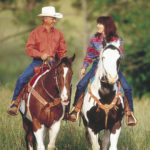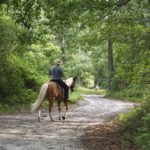Fall is the perfect season for leaving the arena behind and heading for the trails. Before you go, review our list of tips and tactics to make each outing as safe and enjoyable as possible.

SHAPE UP
Trail riding can be more physically challenging than ring work. Condition your horse appropriately for the trails if he is out of shape: On your initial rides, head for shorter and less challenging paths and alternate between walking and trotting. If you ride a trail at a faster pace one day, don’t go as far, and if you plan on riding farther, don’t go as fast.
COMMUNICATION
Take along your cell phone in case of emergency. However, do not think it makes you invincible. Cellular signals may be spotty in some areas, your phone could be damaged in a fall or you could be knocked unconscious. In terms of safety, a phone is no substitute for a riding companion.
FLY AWAY
Before heading out on a trail ride, fill a travel-sized spray bottle with fly repellent and tuck it into the pouch of the saddle pad. A quick mid-ride touchup can help keep the flies at bay on particularly buggy days.
NAVIGATION
Gather maps, brochures and any other available information about the trail ahead of time. Resist the temptation to depend on a companion who knows the area?if a mishap occurs, you may be left alone in a real dilemma.
BE PREPARED
Besides a companion, here are some other essential items to bring along on a short ride in familiar territory in case you encounter trouble on the trail:
– Swiss army knife or Leatherman tool
– whistle, for attracting attention if you need help
– hoof pick
– shoelace or baling twine for emergency tack fixes
For longer outings, you may also want to bring:
– a portable first-aid kit with antiseptic wipes, saline solution, nonstick wound pads, gauze roll, self-adhesive wrap and zinc oxide ointment
– fly spray
– sunscreen
– drinking water
WATCH THE WEATHER
Check the forecast before your outing so you can outfit yourself and your horse appropriately. Also, have a plan for dealing with extreme weather conditions that may suddenly develop. Here’s how to handle a few scenarios:
– Lightning: Seek refuge in a barn or another sturdy shelter until the storm passes. If that’s not an option, take cover in a dry area where you are not near isolated trees or other tall objects. If you’re in an open field, find a low, dry place and squat near the ground. Whatever you do, stay away from water, which conducts lightning. If the storm scares your horse so much that he may injure you or himself, let him go and hunker down.
– Strong winds: Go out into an open space, clear of trees and structures that could blow down and cause injury. Your horse will turn his hindquarters toward the wind to protect himself from airborne dust and debris; follow his lead. If you dismount, let your horse orient himself, then stand in front of his chest so he acts as a windbreak
– Hail: Look for any type of shelter you can find to protect you and your horse from a painful pelting. If none can be found and your horse is calm, position yourself under his neck. If he is agitated, however, let him find his own shelter while you curl up on the downwind side of a hill and protect your head and neck with your arms and/or clothing.
CLEAR SAILING?
There’s little that’s more exciting than a carefree gallop on an open stretch of trail, but if hikers or bikers are crowding the way ahead, excessive speed can be dangerous. Use common sense and keep your speed in check.
GAUGING DRINKABILITY
It’s a hot day and you?ve been on the trail a long time. You pause on the banks of a small creek and your horse noses down for a drink. Do you let him? There are a few clues you can use to judge the potability of water on the trail:
– Movement?Still water is more likely to be stagnant and unsuitable for drinking. Instead, look for running water, such as a creek or stream. As a general rule, do not let your horse drink from standing water, except for recent rain puddles.
– Color?Water in nature isn?t always clear. Just be sure to stay away from any water that is a color not typically found in nature or has an oily sheen.
– Aroma?Do not let your horse drink water that smells strange, the odor could indicate the presence of chemicals or dead animals.
– Surface factors?Mosquitoes dancing on the water indicate that it is stagnant. Blue-green algae, usually found in full sun on the surface of a stagnant pond, can be deadly.
STAY IN LINE
Stay on designated trails, looking for signs or markers put up by the property owner or cairns left by hikers pointing to otherwise unmarked trails. Equestrian trails are designed to sustain high-impact equine use.
This means they are usually well graded and covered with decomposed granite or another durable surface material that reduces erosion and undergoes regular maintenance.
NO SHORTCUTS
Avoid the temptation to ?cut corners? on deep curves and switchbacks. Going off the trail to take a shortcut will lead to erosion, especially on steep hillsides. Stick to the trail, even if it means taking longer to get to your destination.
FRIENDLY FOOTWEAR
If your horse wears shoes, make sure that they are on securely before heading for the trails. Carrying a hoof boot or two can protect his hooves and let you continue your ride in the event of an unexpected shoe loss.
EASY DOES IT
Give your horse extra rein when going up or down a steep slope so he can use his head and neck freely to balance himself. As you ascend a slope, lean forward slightly?grabbing a bit of mane if it helps?but keep your legs aligned below your hips. This will keep you in balance while freeing up the horse’s hindquarters to push up the hill. Going down steep slopes, position your feet in front of you (as if they were resting on the flat ground you’ll eventually reach), then align your shoulders directly above your hips. This will prevent you from tumbling forward over your horse’s shoulders if he stumbles.
DON?T LOOK DOWN
Be quiet and careful as you follow ledge trails that cut into mountainsides. Hold the speed down, particularly if descending. Keep reminding yourself that your horse has no desire to walk off the edge of the trail. Indeed, you?d have trouble forcing him over if you tried.
WATER HAZARDS
Cross unfamiliar water with care, particularly in areas where streams are deeply incised. Foot traffic will keep wearing away at the banks and result in tons of silt in the streambed. On marked trails, cross only at bridges or established fords to avoid damaging embankments.
LOOK AHEAD
While crossing water, fix your vision on the place you wish to land on the opposite side of the stream. Looking in the direction you wish to go helps your horse. Don?t look down into the water as this makes riders dizzy, and that can unbalance your horse while he’s doing his best to pick his footing across the bottom.
THROUGH THE TREES
Protect yourself and riders behind you by using this simple technique when you come upon low-hanging branches. Lift the branch straight up and over your head?do not pull it to one side. As you pass beneath the branch, release it so it drops straight down behind your head toward your horse’s rump. It will not hit him and he will continue to walk under it. And you won?t accidentally swat the rider behind you.
NO SNACKING
Don?t let your horse snatch bites from trailside bushes and trees. Not only is this a distraction, but he may grab a mouthful of a toxic plant.
STEP CAREFULLY
Anywhere trails pass through forested areas, you’re likely to encounter a downed tree or two. If you don’t have a folding saw in your saddlebag, you must find a way around the log, go over it or turn around and go
back. When going over it, keep your horse at a walk so that he can step carefully. Before crossing, scrutinize the top of the log for any protruding branches that could injure his belly and look below and beyond it for snakes or other hazards.
LISTEN TO ME
If your horse has a full-on freakout at the sight of deer, wild boar or any other animal you encounter on the trail, try to get him to focus his attention on you. One good way is to ask for a shoulder-in or a sidepass that turns the horse’s head away from the animal. If you feel solidly in control again, you may want to try riding past the creature, keeping your horse ?on the aids.? Otherwise you can dismount and lead your horse, positioning yourself between him and the animal. Once safely past, give your horse time to regroup and calm down before you remount and continue.
HOMEWARD BOUND
Remember that most horses have an excellent sense of direction, particularly when going home. If you’re unsure of your way but your horse is insistent on heading in a particular direction, trust him.






